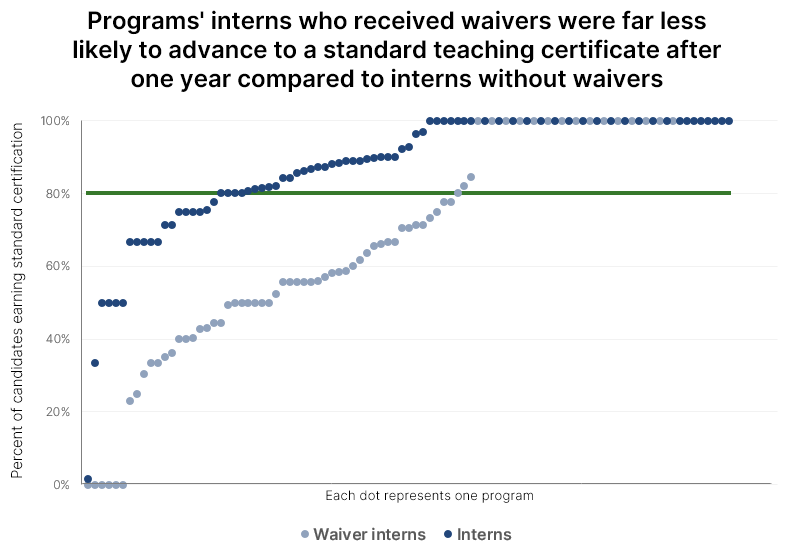As the pandemic quickly took hold in winter and spring of 2020 and schools everywhere moved learning out of classrooms and into homes, Texas faced a challenge shared by states across the country: how to support all the aspiring teachers who were nearing the end of their preparation programs.
Two key teacher licensure requirements that posed the greatest puzzle were licensure tests (in Texas, content pedagogy tests and a general pedagogy and professional responsibilities test, the “PPR”) and clinical experiences (including student teaching in internships). Testing centers shut down or drastically curtailed access, and clinical experiences became a much different (and often impossible) proposition as classrooms moved online. Teacher candidates whose certification was nearly within reach were suddenly at a standstill, and districts were faced with the possibility of needing to meet their fall 2020 hiring needs with emergency permits and substitute teachers.1
To meet these challenges, the governor issued an emergency waiver that allowed the Texas Education Agency to issue waiver certifications that allowed people to become teachers of record before fully meeting the state’s licensure requirements. Now, candidates who were completing their prep program in spring or summer of 2020 could teach for a year without passing their licensure tests; it also granted greater flexibility around internship requirements. These certificates came in two forms:
- Waiver Probationary certificates, for teacher candidates from traditional or alternate routes who had completed all the preparation requirements except passing exams (for candidates completing internships, this would have included their PPR test, and for candidates completing traditional programs, this typically included both the PPR and the content licensure test). These teachers were given an additional year to work as a certified teacher, during which they could work to pass any necessary exams.
- Waiver Intern certificates, for candidates in alt-route programs who had not yet passed the content test (the test of the subjects they will be certified to teach). By rule, once these candidates pass the content test they can complete their internship under a one-year intern certification. The Waiver Intern certificates allowed candidates to begin these internships without first passing the content test.
| Certification category | Preparation pathway | Required tests for waiver certification | Required test for standard certification |
| Waiver Probationary | Traditional or alt-route |
Alt-route: Content;
Traditional: None |
Content test & PPR test |
| Waiver Intern | Alt-route | None | Content test & PPR test |
The state decided to turn this crisis into an opportunity to learn, tracking the outcomes specifically for the “waiver interns,” who were allowed to begin teaching without demonstrating their content knowledge. The state examined whether this approach successfully brought more teachers into the classroom, and also whether they stayed in the classroom, earned standard certificates, and were effective once there.
Based on the data the Texas Education Agency collected so far, they have found some temporary gains accompanied by longer-term challenges.
On the whole, the state issued more certificates (about 9,000 more) in February 2020 to January 2021 than it did during that same window the year before. This increase was driven mostly by waiver probationary certificates (for teachers who had passed their content tests), followed by waiver intern certificates, with about the same number of standard certificates (and far fewer intern and probationary certificates for candidates who met the requirements and did not need the flexibility granted by the regulatory waiver).2
Another positive outcome was that the teachers earning intern and waiver intern certificates during this year (February 2020 to January 2021) were more diverse (specifically, the proportion of Black teachers was about 6 percentage points higher and the proportion of Hispanic teachers was almost one percentage point higher) than the teachers earning an intern certificate the year before.
But, not all the results were as hopeful.
By the end of their internship year, waiver intern teachers did have to pass their content licensure test, which demonstrates that they have a firm foundation in the subjects they’ll be teaching, as well as passing the PPR test and meeting all of their preparation program’s requirements. Waiver intern teachers struggled to meet all the requirements for standard certification at the same rate as the cohort of intern teachers who had already passed their content test before starting their internship.
Waiver intern teachers were 27 percentage points less likely to earn a standard certificate compared with a typical intern. If the waiver interns earned their standard certification at the same rate as interns, there would be another 2,200 individuals achieving a standard certification; instead, these waiver intern candidates were not able to continue teaching as a certified teacher.
Setting the content test as a performance gate for certification necessitates that preparation programs provide a level of training and support to candidates prior to the beginning of the internship, so that they can meet the common bar of the content exam. One
might consider these results an example of how licensure tests are a barrier to the classroom. However, given that the waiver interns did not obtain standard certification at the same rate as those interns who did presumably receive more pre-internship supports, we might rather conclude that waiver interns missed out on support from their preparation programs that was important for their early career success.
Perhaps due to the shift in requirements for entry into internships and the delay in when interns took licensure tests, teacher preparation programs may have had a harder time in supporting interns in earning a standard certification. With interns who had passed the test prior to their internship, the majority of prep programs saw more than 80% of their interns earn a standard certificate. Far fewer prep programs reached the 80% mark of interns earning a standard certification for their waiver intern (see graph below)—and for a handful of prep programs, none of their waiver interns earned a standard certification.

| Few prep programs saw more than 80% of their waiver interns advance to a standard certification, while over half of programs saw more than 80% of their interns without waivers advance. |
The state also saw lower teacher retention rates among the waiver interns compared with a typical intern teacher. About 9 percentage points fewer teachers than in a typical year (equivalent to about 700 teachers) continued teaching the following year.
The racial diversity of the waiver intern cohort did not carry through to interns who earned standard certifications. Compared to white waiver interns, Hispanic/Latino candidates were about 16 percentage points less likely to earn a standard certification, and Black waiver interns were about 33 percentage points less likely to earn a standard certification.
It’s worth noting that teachers with a typical intern certification also have some racial disparity in who earns a standard certification, but these disparities are much smaller than for waiver interns.
Emily Garcia, Associate Commissioner of Educator Preparation, Certification, and Enforcement with the Texas Education Agency summarized these findings: “While the waiver intern policy supported candidates who may not have otherwise had access further into the system, this positive shift in the workforce is not sustained long-term.”
Perhaps the most important question for Texas students is whether their teachers are effective in promoting student learning and building a supportive classroom environment. In a survey of principals, the preparation of waiver intern teachers was scored lower (generally a modest but statistically significant difference) across every domain compared to the preparation of their non-waiver intern colleagues who began teaching the same year.3
The lesson from Texas seems to be that short-term reductions in guardrails for entry into the teaching profession do not lead to long-term gains. Teachers who enter the classroom without meeting typical expectations tend to leave sooner, be less likely to earn a standard certification, and earn lower marks from their principals. The reality of content exams likely prompt preparation programs to offer greater support to their candidates prior to the internship, while encouraging interns to master the content they’ll need to teach so that they can pass licensure exams. While the story continues to unfold as Texas gathers more data about this cohort of teachers, the results to date are clearly not an affirmation of making it easier to become a teacher.
The waiver certifications were only available for one year, and the exam flexibility was not extended. Candidates at alternative certification programs once again have to complete the content exam to earn their intern certificate and complete their internship. Garcia concluded, “Temporary relaxing of standards for teacher preparation can support immediate needs in an emergency, but it did not provide long-term benefits for the overall teacher workforce. When we think about how we can best recruit and support new teachers, the removal or shifting of certification exams does not appear to be the best answer.”
More like this

How some states use licensure test pass rate data to build a stronger, more diverse teacher workforce

Setting sights lower: States back away from elementary teacher licensure tests

We wouldn’t lower standards for pilot licenses—so why teachers?

How states are making licensure tests free to aspiring teachers
Endnotes
- The Texas Education Agency tracks the types of certifications held by newly hired teachers each year here: Employed Teacher Attrition and New Hires 2007-08 through 2021-22 (texas.gov).
- Note that some people earned more than one certificate during this study, so these counts were of certifications issued, not individual teachers.
- The six domains of the
survey are Planning, Instruction, Learning environment, Professional Practices
& Responsibilities, Working with Emergent Bilingual Students, and Working
with Special Education Students.

